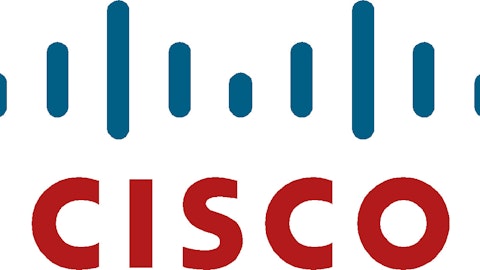The last time web traffic volume was expanding this fast, Microsoft shares shot up from $3.70 to $58.40, establishing a 1,500% gain in just five years. In the same time frame, Cisco Systems, Inc. (NASDAQ:CSCO) saw gains as high as 3,900%! Advanced Micro Devices shares grew 295%, and Intel increased over 1,700%.
If you missed the boat on the last internet boom, you definitely don’t want to miss this one. Why? Because over the next four years, the size of the internet is expected to quadruple.
Why the internet will grow
1). More devices. Mobile phones, tablets, and wearables will continue to penetrate the market. By 2016, there will be 2.5 connections for every person on earth (current population).
2). Faster speeds. Faster travel means higher rates of traffic. Average broadband speeds will more than triple within the next four years.
3). More Wi-Fi. By 2016, more than 50% of Internet traffic is expected to be connected through Wi-Fi.
4). More users. Almost half of the world’s current population will be connected to the internet within four years. Forecasts put the number of connected at 3.4 billion
Alongside rising internet traffic are diminishing fears over cloud security.
Analytics company Comscore found that before adopting cloud services, 45% of small- to medium-sized companies express security concerns. However, after adopting the cloud, 94% actually feel more secure.
As internet traffic and acceptance of cloud security increase, so will the cloud industry as a whole. Leading technology research company Gartner predicts the cloud market to grow by 19% to $131 billion in 2013.
The market will see major gains within this sector, so how can investors position themselves for profit?
I have identified three companies set to reap the benefits of the growing cloud within the coming years.
1. Palo Alto Networks Inc (NYSE:PANW)

The company also recently started offering firewalls on virtual software (this includes cloud-based Web applications) as opposed to on hardware. Gartner estimates 20% of the firewall market will switch to virtual platforms, making Palo Alto Networks Inc (NYSE:PANW) a major competitor in a $1.6 billion market.
Palo Alto Networks Inc (NYSE:PANW) has also begun to place focus on cloud computing in enterprise, partnering with Citrix Systems to provide corporate customers security of access on mobile networks. That said, Palo’s stock has been in a downtrend since September 2012. Don’t jump in with both feet. Look for a bottom signal on the chart. If you play it right, you should be able to get in below $40.
2. Cisco Systems, Inc. (NASDAQ:CSCO)
Cisco Systems, Inc. (NASDAQ:CSCO) has been dominating the market for physical networking equipment — including switches and routers — for some time now. But Cisco wants to be bigger. So the company is switching gears to a new strategy focused on the Internet of Everything, or IoE.
Simply defined, the IoE refers to the idea of an increased connectivity between all objects. Until now, the internet has been a people-centered medium — but non-human objects and machinery are now gaining an increasing amount of access. (For example: Mirrors that can provide basic medical analysis by measuring temperature and pupil dilation, billboards that can target ads based on viewer data and location)
Cisco Systems, Inc. (NASDAQ:CSCO) aims to play a major role in this revolution by connecting these objects through networking and data storage. The company is accomplishing this goal by dropping its consumer-based hardware and aggressively moving towards cloud computing.
The company recently acquired Cloupia and Meraki for cloud management, vCider and Cariden for networking, and BroadHop for cloud programming. The transition has been virtually seamless so far. The company has been able to quickly increase revenue in new markets while maintaining consistent streams from previously successful areas. If you are looking for a solid blue chip winner to hold onto for the next two years, look no further than Cisco Systems, Inc. (NASDAQ:CSCO).
3. Micron Technology, Inc. (NASDAQ:MU)
Micron Technology, Inc. (NASDAQ:MU) designs and manufactures semiconductors for data storage and retrieval. The company provides flash memory and dynamic random-access memory used for storage in computers and servers.
Micron Technology, Inc. (NASDAQ:MU) has seen a small but steady increase in revenue stream over the past three quarters: $1.8 billion, $2.1 billion, and $2.3 billion, sequentially. Considering the current performance of the semiconductor market, this is a very positive sign for Micron.
Currently in production, the Micron Technology, Inc. (NASDAQ:MU) P400m shows that Micron is aiming to enter the booming big data market. Micron is currently trading just off a six-year high, at $12.53 a share, but with a price-to-book ratio of 1.92, Micron Technology, Inc. (NASDAQ:MU) is still fairly cheap. Anywhere in the $10 range would be a steal for any investor.
Foolish conclusion
The internet is just starting to gather speed, and as such, many companies will inevitably capitalize on the booming internet penetration rates. Countries in Africa and Asia will soon have internet capabilities that were considered fantasy just a few years ago, and the above companies are certainly stocks that investors should keep an eye on in the near and long-term.
Chris Johnson has no position in any stocks mentioned. The Motley Fool recommends Cisco Systems.
The article 3 Internet Stocks Set to Soar originally appeared on Fool.com and is written by Chris Johnson.
Chris is a member of The Motley Fool Blog Network — entries represent the personal opinion of the blogger and are not formally edited.
Copyright © 1995 – 2013 The Motley Fool, LLC. All rights reserved. The Motley Fool has a disclosure policy.



